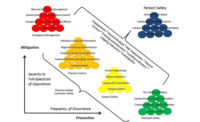The pragmatic development of ongoing hazard analysis to reach high-reliability goals

High-reliability organizations are those whose leaders strive to create the safest and most effective hazard controls and then constantly re-assess these operations for any possibility of failure so that it can be resolved before an incident occurs. These high-reliability processes require the high-reliability principles: Preoccupation with failure, reluctance to simplify, sensitivity to operations, deference to expertise and commitment to resilience. These principles often come across to the uninitiated as abstract concepts while to others, they counter the very hierarchal structures they’ve known since entering the workforce, military, public service or other organization.
For example, while organizations are striving to meet customer satisfaction standards, regulatory compliance measurements and key performance indicators, how exactly does one display preoccupation with failure? What does that look like? Obviously, organizations are much attuned to operations and their outcomes, so how does an organization show sensitivity to operations? If an organization, especially military, fire protection and law enforcement units has had centuries of hardwired chains of command, how exactly do these teams learn to defer to expertise when that supposed expert is not the ranking person on the scene? (Christianson, Sutcliff et al., 2011). In short, how does high-reliability become operationalized?
Operationalization
In seeking to operationalize high-reliability theory and to create an organization consistently seeking the betterment of their operations, the timeline of an incident can be consulted (Worden & Lombardo, 2016). Within this timeline, all proactive measures such as hazard analyses, information programs and leading indicators fall to the left to the incident, a phenomenon Riley and Van Horne of the United States Marine Corps referred to as striving to keep all actions to the ‘left of bang’ (Riley & Van Horne, 2014). All actions falling to the right of the incident are reactive, the actions responding, recovering and reconstituting from the incident. By placing operational, actionable activities around each element of the incident timeline, high-reliability can transition from an abstract concept to a pragmatic, actionable practice.
Hazard analysis
Hazard analyses are an ongoing, constant practice of proactive organizations. Without consistent and recurring efforts to identify possible failure modes and means to resolve them, the organization will be vulnerable to unknown hazards and threats. With this, hazard analyses must first be completed through a process of brainstorming and also through a reactive process of identify failure modes already observed. These analyses must cover possible hazards and threats and who in the organization is vulnerable to the hazard/threat. These hazards and threats can also be assessed by their function of frequency of previous occurrences and possible severity of consequence should the hazard/threat manifest itself. This can help in identifying which hazards/threats are more likely to manifest so that resources can be allocated to them more quickly when budget, manpower and other constraints are applicable.
With this, the organization has now created a pragmatic means to be preoccupied with failure. Additionally, by gathering information on processes, equipment and other factors in the workplace, deference to expertise is also now exemplified in an actionable process.
Hazard controls and information programs
With hazards analyzed, hazard controls must be put in place for each to prevent or mitigate injuries or damage from the hazard. These hazards must be addressed with the most effective hazard control starting with elimination and moving onto substitution, engineering, administration and Personal Protective Equipment if not possible. Additionally, with any hazard control, training must be provided to ensure all affected employees know how to use the control, where it is located, how to maintain it and other means to the effective safe operations how enabled by the hazard control implemented.
With these hazard controls now in place and employees trained, an information and communication program - everything from bulletin boards to safety huddles to emails to meetings to training sessions and everything in between – provides consistent and recurring reinforcement of the expectation of the use of the applicable hazard controls. Through these hazard control developments and their associated information programs, the organization has now created a pragmatic means to continue deferring to experts on each process to create the most effective hazard control while also beginning to engage in reluctance to simplify. Often, organizations will assume that employees have been trained on a process and that this will enable safe operations when, in fact, the most effective hazard control has not been implemented so the safest possible operations are not possible. The organization has tried to simplify the process where it should not have been.
Leading and lagging indicators
With safe processes now implemented, the potential incident on the incident timeline falls between leading and lagging indicators. Leading indicators are the processes developed to validate whether or not the pre-determined safe processes and hazard controls are being operationally used and whether or not they are operationally effective and as safe as possible. For example, if the determined hazard control for a table saw is to use the machine guard over the point of operation/saw blade, a leading indicator could be an observation to monitor whether or not the guard is being used and also whether or not the guard is providing the proper safety as intended.
On the contrary, lagging indicators are the measurements of how many times and badly the consequences were – physically, financially and otherwise – when the hazard controls and safe work practices were not followed. For example, should the previously discussed machine guard not be used and incidents occur, lagging indicators – those indicators developed and measured after the incident has occurred – could be the number of incidents from the same causal factors, the causal factors themselves – such as lacks of training, lacks of equipment, human error or other – financial implications of the incidents or other. The major difference between leading indicators and lagging indicators is that a leading indicators provides critical data that can be used to prevent injuries while lagging indicators can be used to prevent future injuries but only based on data derived from injuries having already occurred.
In terms of high-reliability operations, leading and lagging indicators again allow for deference to expertise in that those most knowledgeable of the tasks at hand should be consulted to determine which indicators to determine, measure and analyze regardless of rank, title or position. Additionally, indicator development allows for sensitivity to operations in that these indicators should be developed to capture data during normal operational tempos so as to not interrupt workflows and also allow for a commitment to resilience in that lagging indicators, despite an incident having occurred, allow for resilience from the incident and a means to determine what went wrong, whether the safe process and hazard controls was followed/used, whether the safe process and hazard control was sufficient or if another culprit was at hand for the incident. In either case, a thorough investigation into the incident based on the applicable lagging indicators allows for a pragmatic means to operationalize the appropriate high-reliability concepts and to use them to benefit safety throughout the organization.
Ultimately, high-reliability organizations must understand and implement high-reliability principles as a real-world, pragmatic, operationalized part of their operations. These must exist in every part of the operation, every day. There cannot be a once-a-year safety stand-down. These high-reliability facets must be in effect every day during every operations with every employee. The line employee must have just as must influence on the safety of a process as the general manager, especially as a subject matter expert. There is a great deal of swallowing pride that goes into high-reliability concepts – without it, the concept cannot become realized. However, when realized, it can create a safety culture above and beyond all else.
References
- Christianson, M.K., Sutcliffe, K.M., Miller, M.A. & Iwashyna, T,J. (2011). Becoming a high reliability organization. Critical Care. Retrieved from https://www.ncbi.nlm.nih.gov/pmc/articles/PMC3388695/
- Riley, J. & Van Horne, P.V. (2014). Left of bang. New York, NY: Black Irish Entertainment. Risk assessments: The catch-all for hazard analysis. (2011). Briefings on Hospital Safety, 19(3), 1-5.
- Worden, C. & Lombardo, K. (2016). Situational awareness: The often-ignored hazard control. AOHP Journal, 36(3), 8-13.
Looking for a reprint of this article?
From high-res PDFs to custom plaques, order your copy today!









